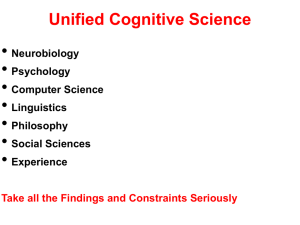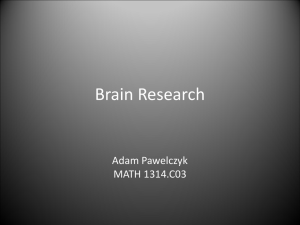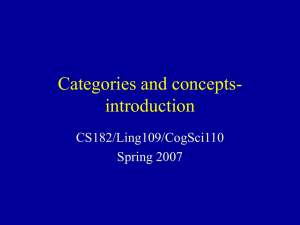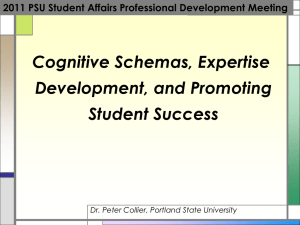Categories and concepts- introduction CS182/Ling109/CogSci110 Spring 2008
advertisement
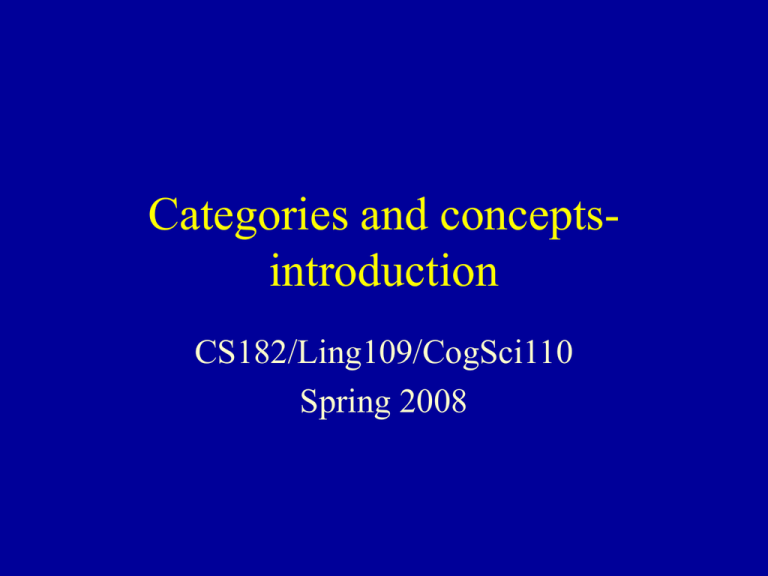
Categories and conceptsintroduction CS182/Ling109/CogSci110 Spring 2008 Lecture Outline • Categories – Basic Level – Prototype Effects – Neural Evidence for Category Structure • Aspects of a Neural Theory of concepts • Image Schemas – Description and types – Behavioral Experiment on Image Schemas • Event Structure and Motor Schemas Concepts are not categorical Mother • The birth model The person who gives birth is the mother • The genetic model The female who contributes the genetic material is the mother • The nurturance model The female adult who nurtures and raises a child is the mother of the child • The marital model The wife of the father is the mother • The genealogical model The closest female ancestor is the mother (WFDT Ch.4, p.74, p.83) Radial Structure of Mother Genetic mother Stepmother Unwed mother Surrogate mother Biological mother Adoptive mother Central Case Foster mother Birth mother Natural mother The radial structure of this category is defined with respect to the different Marriage • What is a marriage? • What are the frames (or models) that go into defining a marriage? • What are prototypes of marriage? • What metaphors do we use to talk about marriages? • Why is this a contested concept right now? Concepts and radial categories Concepts can get to be the "prototype" of their category in various ways. • Central subcategory (others relate to this) • Amble and swagger relate to WALK • Shove relates to PUSH • Essential (meets a folk definition: birds have feathers, beaks, lay eggs) • Move involves change of location. • Typical case (most are like this: "sparrow") • Going to a conference involves air travel. • Ideal/anti-ideal case (positive social standard: "parent"); antiideal case (negative social standard: "terrorist") • Stereotype (set of attributes assumed in a culture: "Arab") • Salient exemplar (individual chosen as example) Category Structure • Classical Category: – necessary and sufficient conditions • Radial Category: – a central member branching out to less-central and non-central cases – degrees of membership, with extendable boundary • Family Resemblance: – every family member looks like some other family member(s) – there is no one property common across all members (e.g. polysemy) • Prototype-Based Category • Essentially-Contested Category (Gallie, 1956) (e.g. democracy) • Ad-hoc Category (e.g. things you can fit inside a shopping bag) Neural Evidence for category structure • Are there specific regions in the brain to recognize/reason with specific categories? Category Naming and Deficits • People with brain injury have selective deficits in their knowledge of categories. • Some patients are unable to identify or name man made objects and others may not be able to identify or name natural kinds (like animals) A PET Study on categories (Nature 1996) Study • 16 adults (8M, 8F) participated in a PET (positron emission tomography) study. – Involves injecting subject with a positron emitting radioactive substance (dye) – Regions with more metabolic activity will absorb more of the substance and thus emit more positrons – Positron-electron collisions yield gamma rays, which are detected • Increased rCBF (regional changes in cerebral blood flow) was measured – When subjects viewed line drawings of animals and tools. The experiment • Subjects looked at pictures of animals and tools and named them silently. • They also looked at noise patterns (baseline 1) • And novel nonsense objects (baseline 2) • Each stimulus was presented for 180ms followed by a fixation cross of 1820 ms. • Drawings were controlled for name frequency and category typicality medial lateral Left middle temporal gyrus ACC Premotor Calcarine Sulcus Conclusions • Both animal and tool naming activate the ventral temporal lobe region. • Tools differentially activate the ACC, pre-motor and left middle temporal region (known to be related to processing action words). • Naming animals differentially activated left medial occipital lobe (early visual processing) • The object categories appear to be in a distributed circuit that involves activating different salient aspects of the category. What are schemas? – Regularities in our perceptual, motor and cognitive systems – Structure our experiences and interactions with the world. – May be grounded in a specific cognitive system, but are not situation-specific in their application (can apply to many domains of experience) Basis of Image schemas • • • • Perceptual systems Motor routines Social Cognition Image Schema properties depend on – Neural circuits – Interactions with the world Image schemas • Trajector / Landmark (asymmetric) TR – The bike is near the house – ? The house is near the bike • Boundary / Bounded Region LM boundary bounded region – a bounded region has a closed boundary • Topological Relations – Separation, Contact, Overlap, Inclusion, Surround • Orientation – Vertical (up/down), Horizontal (left/right, front/back) – Absolute (E, S, W, N) Similarity: • Perceptual and motor systems • Basic functional interactions with the world • Environment Variation: Cross-linguistic variation in how schemas are used. Cross-linguistic Variations English Japanese Tamil English AROUND ON OVER IN Bowerman & Pederson Dutch OP OM AAN BOVEN IN Bowerman & Pederson Chinese ZHOU LI SHANG Bowerman & Pederson Spatial schemas • • • • • TR/LM relation Boundaries, bounded region Topological relations Orientational Axes Proximal/Distal Representing image schemas schema name schema Source-Path-Goal roles source path goal trajector role name schema Container roles interior exterior portal boundary Boundary Source Trajector Interior Portal Goal Path Exterior These are abstractions over sensorimotor experiences. Schema Formalism SCHEMA <name> SUBCASE OF <schema> EVOKES <schema> AS <local name> ROLES < self role name>: <role restriction> < self role name> <-> <role name> CONSTRAINTS <role name> <- <value> <role name> <-> <role name> <setting name> :: <role name> <-> <role name> <setting name> :: <predicate> | <predicate> Trajector/Landmark Schema • Roles: Trajector (TR) – object being located Landmark (LM) – reference object TR and LM may share a location (at) TR/LM -- asymmetry • The cup is on the table • ?The table is under the cup. • The skateboard is next to the post. • ?The post is next to the skateboard. Boundary Schema Region A Region B Boundary Roles: Boundary Region A Region B Bounded Region Roles: Boundary: closed Bounded Region Background region Topological Relations • Separation Topological Relations • Separation • Contact Topological Relations • Separation • Contact • Coincidence: Topological Relations • Separation • Contact • Coincidence: - Overlap Topological Relations • Separation • Contact • Coincidence: - Overlap - Inclusion Topological Relations • Separation • Contact • Coincidence: - Overlap - Inclusion - Encircle/surround Orientation • Vertical axis -- up/down up above upright below down Orientation Horizontal plane – Two axes: Language and Frames of Reference • There seem to be three prototypical frames of reference in language (Levinson) – Intrinsic – Relative – Absolute Intrinsic frame of reference left back front right Relative frame of reference right?? back front left?? Absolute frame of reference west south north east TR/LM and Verticality Schemas • The book is under the table. up down under Proximal/Distal Schema . Simple vs. Complex Schemas Container Schema • Roles: – Interior: bounded region – Exterior – Boundary C TR/LM + Container out in TR C TRC Container Schema Elaborated – Complexities –more roles/specifications: • Boundary properties – Strength – Porosity • Portals Source-Path-Goal Constraints: initial = TR at Source central = TR on Path final = TR at Goal Source Path Goal SPG -- simple example She drove from the store to the gas station. TR = she Source = the store Goal = the gas station Source Path Goal SPG and Container She ran into the room. SPG. Source ↔ Container.Exterior SPG.Path ↔ Container.Portal SPG. Goal ↔ Container.Interior PATH landmarks past across along LM LM LM Part-Whole Schema Part Whole Representing image schemas semantic schema Source-Path-Goal roles: source path goal trajector semantic schema Container roles: interior exterior portal boundary Boundary Source Trajector Interior Portal Goal Path Exterior These are abstractions over sensorimotor experiences. Language and Spatial Schemas • People say that they look up to some people, but look down on others because those we deem worthy of respect are somehow “above” us, and those we deem unworthy are somehow “beneath” us. • But why does respect run along a vertical axis (or any spatial axis, for that matter)? Much of our language is rich with such spatial talk. • Concrete actions such as a push or a lift clearly imply a vertical or horizontal motion, but so too can more abstract concepts. • Metaphors: Arguments can go “back and forth,” and hopes can get “too high.” Simulation-based language understanding construction WALKED form selff.phon [wakt] meaning : Walk-Action constraints selfm.time before Context.speech-time selfm..aspect encapsulated “Harry walked into the cafe.” Utterance Analysis Process Constructions General Knowledge Semantic Specification Belief State CAFE Simulation The INTO construction construction INTO subcase of spatial-prep form selff .phon [Inthuw] meaning evokes Trajector-Landmark as tl evokes Container as cont evokes Source-Path-Goal as spg tl.trajector spg.trajector tl.landmark cont cont.interior spg.goal cont.exterior spg.source Simulation specification A simulation specification consists of: - schemas evoked by constructions - bindings between schemas Language and Thought Language Thought cognitive processes • We know thought (our cognitive processes) constrains the way we learn and use language • Does language also influence thought? • Benjamin Whorf argues yes • Psycholinguistics experiments have shown that linguistics categories influence thinking even in non-linguistics task Universal Schemas and Cultural Frames • Image Schemas appear to be universal – Colors – Spatial schemas – container, support – Action Schemas – grasp, general controller • Frames are specific to a culture – Commercial Transaction (CT), stock market – Baseball, Cricket – Linguistics, Philosophy • Frames have roles and constraints like schemas. – “shortstop” evokes the baseball frame – framing has a major role in politics Frames • Frames are conceptual structures that may be culture specific • Words evoke frames – The word “talk” evokes the Communication frame – The word buy (sell, pay) evoke the Commercial Transaction (CT) frame. – The words journey, set out, schedule, reach etc. evoke the Journey frame. • Frames have roles and constraints like schemas. – CT has roles vendor, goods, money, customer. • Words bind to frames by specifying binding patterns – Buyer binds to Customer, Vendor binds to Seller. Event Frames Event frames have temporal structure, and generally have constraints on what precedes them, what happens during them, and what state the world is in once the event has been completed. Sample Event Frame: Commercial Transaction Initial state: Vendor has Goods, wants Money Customer wants Goods, has Money Transition: Vendor transmits Goods to Customer Customer transmits Money to Vendor Final state: Vendor has Money Customer has Goods Sample Event Frame: Commercial Transaction Initial state: Vendor has Goods, wants Money Customer wants Goods, has Money Transition: Vendor transmits Goods to Customer Customer transmits Money to Vendor Final state: Vendor has Money Customer has Goods (It’s a bit more complicated than that.) Partial Wordlist for Commercial Transactions Verbs: pay, spend, cost, buy, sell, charge Nouns: cost, price, payment Adjectives: expensive, cheap Meaning and Syntax The various words that evoke this frame introduce the elements of the frame in different ways. , goods and money Information expressed in sentences containing these words occurs in different places in the sentence depending on the word. An experiment on Image Schemas • Richardson and Spivey (2003) operationalized this question by presenting participants with sentences and testing for spatial effects on concurrent perceptual tasks. • An interaction between linguistic and perceptual processing would support the idea that spatial representations are inherent to the conceptual representations derived from language comprehension (Barsalou, 1999). Example verbs The servant argued with the master. The storeowner increases the price. The girl hopes for a pony. The athlete succeeds at the tournament. The miner pushes the cart. Aspect angles • Vertical was 90 and horizontal 0. – Mean aspect angles were – (12=H, 42=Neutral, 69=V) Example verbs Forced choice Free form The servant argued with the master. 20 11 H The storeowner increases the price. 85 75 V The girl hopes for a pony. 55 36 V The athlete succeeds at the tournament. 68 44V The miner pushes the cart. 10 12 H AVERAGE ASPECT ANGLE The experiment • Each trial began with a central fixation cross presented for 1000 ms. A sentence was presented binaurally through headphones. There was then a pause of 50, 100, 150 or 200 ms. – This randomized “jitter” was introduced, so that participants could not anticipate the onset of the target visual stimulus. • The target, a black circle or square, then appeared in either the top, bottom, left or right position, and remained on screen for 200 ms. • Participants were instructed to identify the stimulus as quickly as possible, pressing one key to indicate a circle and another to indicate a square. • Reaction times and accuracy rates were recorded. • The questions were interrogative forms of the filler sentences with an object substitution in half of the cases (e.g., “Did the dog fetch the ball/stick?”). Participants responded “yes” or “no” by pressing designated keys. Summary of Result • There is an interference effect when the verb category is vertical (from norming study) and the visual stimulus object is vertical. • Issues with the experiment? Action Words- an fMRI study • Somatotopic Representation of Action Words in Human Motor and Premotor Cortex – Olaf Hauk, Ingrid Johnsrude,and Friedemann Pulvermuller* – Medical Research Council, Cognition and Brain Sciences Unit Cambridge, United Kingdom – Neuron, Vol. 41, 1–20, January 22, 2004, Copyright .2004 by Cell Press Traditional theory • Unified meaning center in the left temporal lobe. – Connected to Wernicke’s area – Experiments on highly imageable words/nouns. • Vocalization and grammar associated with frontal lobe – Connected to Broca’s area Do action words activate the motor cortex • Given: Cortical representations of the face, arm, and leg are discrete and somatotopically organized in the motor and premotor cortex • Hypothesis: Words referring to actions performed with the face, arm, or leg would activate premotor networks. – neurons processing the word form and those processing the referent action should frequently fire together and thus become more strongly linked, resulting in word-related networks overlapping with motor and premotor cortex in a somatotopic fashion. • Experiment: An fMRI study with word stimuli from different effectors (face, arm, or leg). ROI based on movements (face, arm, leg) Somatotopy in STS and MC The Experiment • In order to find appropriate stimulus words, a rating study was first performed. – Subjects were asked to rate words according to their action and visual associations and to make explicit whether the words referred to and reminded them of leg, arm, and face movements that they could perform themselves • From the rated material, 50 words from each of the three semantic subcategories were selected and presented in a passive reading task to 14 right-handed volunteers, while hemodynamic activity was monitored using event-related fMRI. • The word groups were matched for important variables, including word length, imageability, and standardized lexical frequency, in order to minimize physical or psycholinguistic differences that could influence the hemodynamic response. • To identify the motor cortex in each volunteer individually, localizer scans were also performed, during which subjects had to move their left or right foot, left or right index finger, or tongue. Norming (B) Mean ratings for the word stimuli obtained from study participants. Subjects were asked to give ratings on a 7 point scale whether the words reminded them of face, arm, and leg actions. The word groups are clearly dissociated semantically (face-, arm-, and leg-related words). All Actions (C) Activation produced by all action words pooled together. Results are rendered on a standard brain surface (left) and on axial slices of the same brain (right). Correlation with BOLD Signal Neural Evidence for category structure • Are there specific regions in the brain to recognize/reason with specific categories? • No, but there are specific circuits distributed over relevant regions of the brain. • What might the general characteristics of such circuits look like? Schemas and Frames in Language • Language Understanding Model – Analysis – Semantic Specification – Enactment or Simulation • Semantic Specification (SemSpec) – Combines Schemas and Frames – Links (bindings) determine particular meaning • Enactment – Based on system goals – Uses SemSpec and world knowledge
